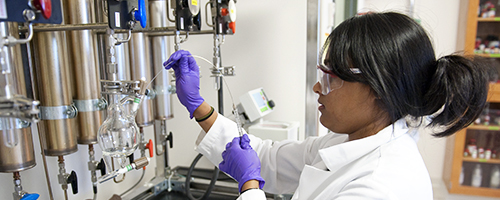Document Type
Article
Publication Date
6-8-2009
Publication Title
Biomacromolecules
Abstract
We report an approach to the design of reactive polymer films that can be functionalized post-fabrication to either prevent or promote the attachment and growth of cells. Our approach is based on the reactive layer-bylayer assembly of covalently crosslinked thin films using a synthetic polyamine and a polymer containing reactive azlactone functionality. Our results demonstrate (i) that the residual azlactone functionality in these films can be exploited to immobilize amine-functionalized chemical motifs similar to those that promote or prevent cell and protein adhesion when assembled as self-assembled monolayers on gold-coated surfaces and (ii) that the immobilization of these motifs changes significantly the behaviors and interactions of cells with the surfaces of these polymer films. We demonstrate that films treated with the hydrophobic molecule decylamine support the attachment and growth of mammalian cells in vitro. In contrast, films treated with the hydrophilic carbohydrate D-glucamine prevent cell adhesion and growth almost completely. The results of additional experiments suggest that these large differences in cell behavior can be understood, at least in part, in terms of differences in the abilities of these two different chemical motifs to promote or prevent the adsorption of protein onto film-coated surfaces. We demonstrate further that this approach can be used to pattern regions of these reactive films that resist the initial attachment and subsequent invasion of mammalian cells for periods of at least one month in the presence of serum-containing cell culture media. Finally, we report that films that prevent the adhesion and growth of mammalian cells also prevent the initial formation of bacterial biofilms when incubated in the presence of the clinically relevant pathogen Pseudomonas aeruginosa. The results of these studies, collectively, suggest the basis of general approaches to the fabrication and functionalization of thin films that prevent, promote, or pattern cell growth or the formation of biofilms on surfaces of interest in the contexts of both fundamental biological studies and a broad range of other practical applications.
Volume
10
Issue
6
First Page
1564
Last Page
1574
DOI
10.1021/bm9001552
ISSN
15257797
Version
Author's Accepted Manuscript
Recommended Citation
Buck, Maren E.; Breitbach, Anthony S.; Belgrade, Sonja K.; Blackwell, Helen E.; and Lynn, David M., "Chemical Modification of Reactive Multilayered Films Fabricated from Poly(2-Alkenyl Azlactone)s: Design of Surfaces that Prevent or Promote Mammalian Cell Adhesion and Bacterial Biofilm growth" (2009). Chemistry: Faculty Publications, Smith College, Northampton, MA.
https://scholarworks.smith.edu/chm_facpubs/38


